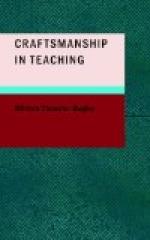All this may seem very remote from the prosaic task of teaching pupils how to study; and yet it will lend its influence toward the attainment of that end. For, after all, we must lead our pupils to see that some books, in spite of their formidable difficulties and their apparent abstractions, are still close to life, and that the truth which lies in books, and which we wish them to assimilate, has been wrought out of human experience, and not brought down miraculously from some remote storehouse of wisdom that is accessible only to the elect. We poke a good deal of fun at book learning nowadays, and there is a pedantic type of book learning that certainly deserves all the ridicule that can be heaped upon it. But it is not wise to carry satire and ridicule too far in any direction, and especially when it may mean creating in young minds a distrust of the force that, more than any other single factor, has operated to raise man above the savage.
V
To teach the child the art of study means, then, that we take every possible occasion to impress upon his mind the value of study as a means of solving real and vital problems, and that, with this as an incentive, we gradually and persistently and systematically lead him to grasp the method of study as a method,—that is, slowly and gradually to abstract the method from the particular cases to which he applies it and to emotionalize it,—to make it an ideal. Only in this way, so far as we may know, can the art be so generalized as to find ready application in his later life. To this end, it is essential that the steps be taken repeatedly,—not begun to-day and never thought of again until next year,—but daily, even hourly, insuring a little growth. This means, too, not only that the teacher must possess a high degree of patience,—that first principle of pedagogic skill,—but also that he have a comprehensive grasp of the problem, and the ability to separate the woods from the trees, so that, to him at least, the chief aim will never be lost to view.




